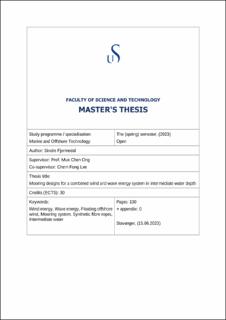| dc.description.abstract | Over the past few decades, the renewable energy industry has expanded offshore in response to the growing demand for clean and sustainable energy. Larger structures with greater power output and less visual disturbance from shore are some of the reasons that motivate the development. Floating energy systems such as offshore wind turbines and wave energy converters (WECs) offer significant potential for producing clean, sustainable energy. The levelized cost of energy from wind and wave energy can potentially be reduced by developing combined wind and wave energy systems which allows for the co-sharing of infrastructure such as mooring systems, supporting platforms and power cables.
In the present study, different mooring systems of a combined wind and wave energy system – the semi-submersible torus flap combination (STFC) concept, deployed in intermediate water depths are developed. STFC consists of a torus WEC, three flap type WECs and a 5 MW NREL reference wind turbine. Fully coupled time-domain analysis of STFC under aligned wind and wave conditions has been performed using SIMA, a software for the analysis of marine operations. The tension-stretch relationship of polyester ropes is modelled using the Syrope model. Six environmental conditions at 50 m water depth representing operational conditions of STFC have been simulated.
The findings of this study have led to the production of two papers focusing on the mooring systems of STFC. The first paper compares catenary and taut mooring systems against a hybrid system consisting of chains, polyester ropes and a buoy. The results are presented in terms of system restoring forces, system natural periods, motion responses, mooring line tensions responses and the cost of mooring. Lastly, a design recommendation for the mooring system of STFC is given. The second paper focuses on a parametric study of the anchor radius of a polyester-based taut mooring system in order to reduce the mooring footprint and cost. The system restoring stiffness is kept constant while anchor spacing, mooring line length, cross-sectional area and minimum breaking load are proportionally reduced. Results are presented in terms of motion responses and mooring line tension responses.
In the first paper, the deployment of a hybrid mooring system is seen to decrease the non-linearity of tension responses, mooring stiffness, and the cost of mooring when compared to catenary and taut mooring systems. No slack line, vertical load on the anchor or contact between the polyester ropes and seabed is observed. Hybrid mooring systems offer solutions with the lowest cost as the combination of polyester ropes and drag-embedment anchors significantly reduce cost. In the second paper, a reduction in anchor radius while maintaining similar surge and sway restoring stiffnesses is seen to reduce pre-tension. Consequently, the yaw stiffness reduces, and a longer yaw natural period is observed between the largest and smallest anchor radius. The maximum tension increases with decreasing anchor radius due to increased surge resonant response. No event of slack line is observed. The minimum tension decreases at an increasing rate as the anchor radius decreases, suggesting that a further proportional reduction of the anchor radius would result in a slack line. | |
